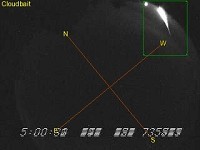
|
Peterson says Friday night's meteor was pretty rare, normally happening only once or twice a year. "These things are so bright and so sudden and they're so beautiful they're kind of a once in a lifetime thing when you see one and people really really remember them," Peterson said.
Together with the Denver Museum of Nature and Science, Peterson's backyard laboratory monitors a network of cameras and telescopes across the state all set up to capture events like Friday night's fire ball. "They look at the sky all night long and so when these events happen we catch them on multiple cameras and we can triangulate," Peterson explains.
He says the unusual angle of the flare ruled it out from being part of the annual Lyrid meteor show which is taking place this weekend. "It was just a sporadic fireball, a big piece of space debris that came in and burned up over the western half of the state."
But for just being space debris, it certainly put on quite a show. Jody Wolkensdorfer of Colorado Springs wrote to News First ,"My first though was, WOW...that is a very long lasting falling star! Then all of the sudden there was a very large green ball which turned into a bright red fiery ball with sparks and flashed everywhere in the sky."
Carol Dial's son was skate boarding at Goose Gossage park when they saw the meteor. The teens ran to the car to grab a video camera but the light had already left.
Both reported seeing the meteor drop in the mountains either behind Garden of the Gods or the U.S. Air Force Academy. In reality it burned up in the atmosphere several miles above Western Colorado near the Utah boarder.
Peterson says it's common for people to misjudge how close a meteor really is. "Usually people think meteors are landing really close and they're not," Peterson said. "There's an illusion at night, you don't have good depth perception, you don't know how far away something is and so, you see something bright, it comes down and it's eventually very far away."
Peterson encourages people who witnessed Friday's meteor to email him a report.
The Colorado Springs Astronomical Society is planning a public star party at Bear Creek Park in Colorado Springs Saturday and Sunday night to watch the Lyrid shower.
Click here to watch the meteor as it burns up.



Comment: "Peterson says Friday night's meteor was pretty rare, normally happening only once or twice a year."
Remember this sighting that was reported in early January as 'space junk'.
Looks like Denver has hit its quota for the year and it is only April.